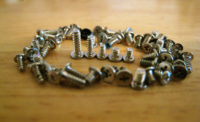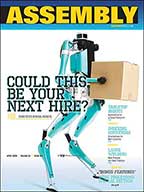ASSEMBLY recently asked the following experts to share some tips on this topic: Mike Abbott, director of technical sales and licensing at Phillips Screw Co.; Dave Archer, president of Archetype Joint LLC and author of ASSEMBLY’s “Fastening Threads” column; Leon Attarian, director of global marketing at PennEngineering; Boris Baeumler, applications engineer at DEPRAG Inc.; Vic Glenn, president of Design Tool Inc.; Neil Maniccia, global product group manager for ASG Precision Fastening, a division of Jergens Inc.; Jarrod Neff, marketing manager at Visumatic Industrial Products Inc.; Greg Pflum, president of Performance Feeders Inc.; andGene Simpson, vice president of quality and engineering at Semblex Corp.
ASSEMBLY:What's the biggest mistake that engineers make with assembly applications involving small screws?
Abbott:Underestimating or overestimating assembly or failure torque. In thread forming applications in plastics and metals, getting the correct assembly torque is often troublesome. The correct torque is extremely variable and dependent on the size and tolerances of the boss hole, length of engagement, boss and component material types.
Archer:The answer depends on the company involved. For example, defense contractors often develop products that contain tightly packaged electronics modules within much larger products and assemble them manually. Here, the problems usually stem from inadequate basic consideration of the design engineer for the handling and access problems associated with small assemblies within complex packages.
On the other hand, to a cell phone engineer, a #4 screw is large. The high assembly rate and similar product configuration result in more structured assembly methods that, in turn, usually restrict fastener selection decisions. Here, the manufacturing engineer will have greater influence on productivity, with selection of assembly equipment and tooling design of critical importance. In these cases, the tendency to “don’t fix it if ain’t broke” and the decreased assembly flexibility will lessen the likelihood of trying screwdriving advances, whether in the screw or the driver.
Attarian:Failing to question whether screws are the best option for the application. Other, more beneficial attachment methods may be available.
Baeumler:Engineers must not underestimate the complexity in terms of assembly. It makes sense to involve an assembly specialist in a very early stage of product development. We offer our customers a series of services to help overcome the challenges, such as a screw joint analysis to prove the right size or shape of a fastener, or the related screw boss in the product, and support in terms of guidelines to design screw and product toward trouble-free assembly.
Engineers [often] apply company-standard solutions to the more complex small screw assembly tasks. There are specifically designed standard and customized solutions available for very small screws.
What’s known for larger screw assembly should not automatically be applied to small screw assembly applications. This will be a costly and time-consuming mistake.
Glenn: The biggest mistake that we see with assembly applications involving small screws is the lack of clearance allowed around the screw head for driver components. For example, screws are too close to the wall of the customer’s application. Also, receiving applications from customer where assembly parts are not put together well for good part alignment.Maniccia:Thread-forming applications can depend widely on the tolerances held by the mold when producing the part from the mold. Sometimes, design engineers will specify a slotted-head fastener. This can make it very challenging to keep the bit engaged during the assembly process. However, we always can use a spring-loaded finder. Location of the fastener in reference to a side wall, counter bore, blind hole or electronic component [can also cause problems].
Neff:Not giving themselves enough thread length on the screw shank. There can be quite a bit of frictional variation between contact surfaces during joining which often gets exaggerated by imperfections, especially in low-cost materials. Sometimes, just one extra thread can make all the difference in achieving repeatable screw drives.
Pflum:Not paying attention to the transfer area between the feeding portion and the customer’s portion of the machine. The transfer between track and end stop or mechanism can be a problem area if not done properly.
Simpson:One of the biggest mistakes engineers make with fastener designs and assemblies is not limited to small screws—it’s not engaging their suppliers early enough in the design process. As a result, a significant amount of activity is spent resolving avoidable issues which could have been avoided. In these cases, when suppliers are engaged early in the process, they can provide guidance and insight to the design. That can actually improve and simplify the assembly process; in many cases, saving time and cost.






